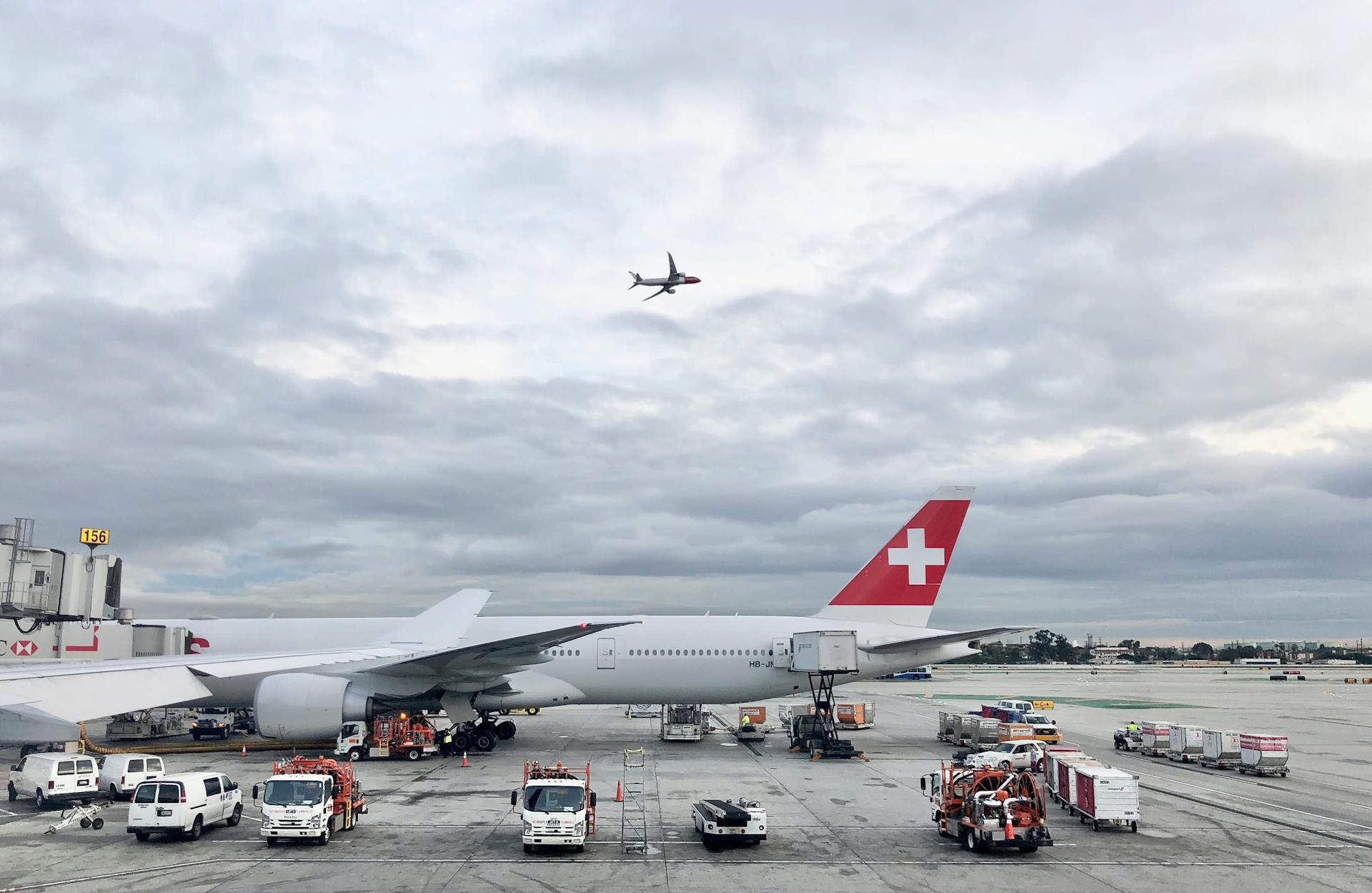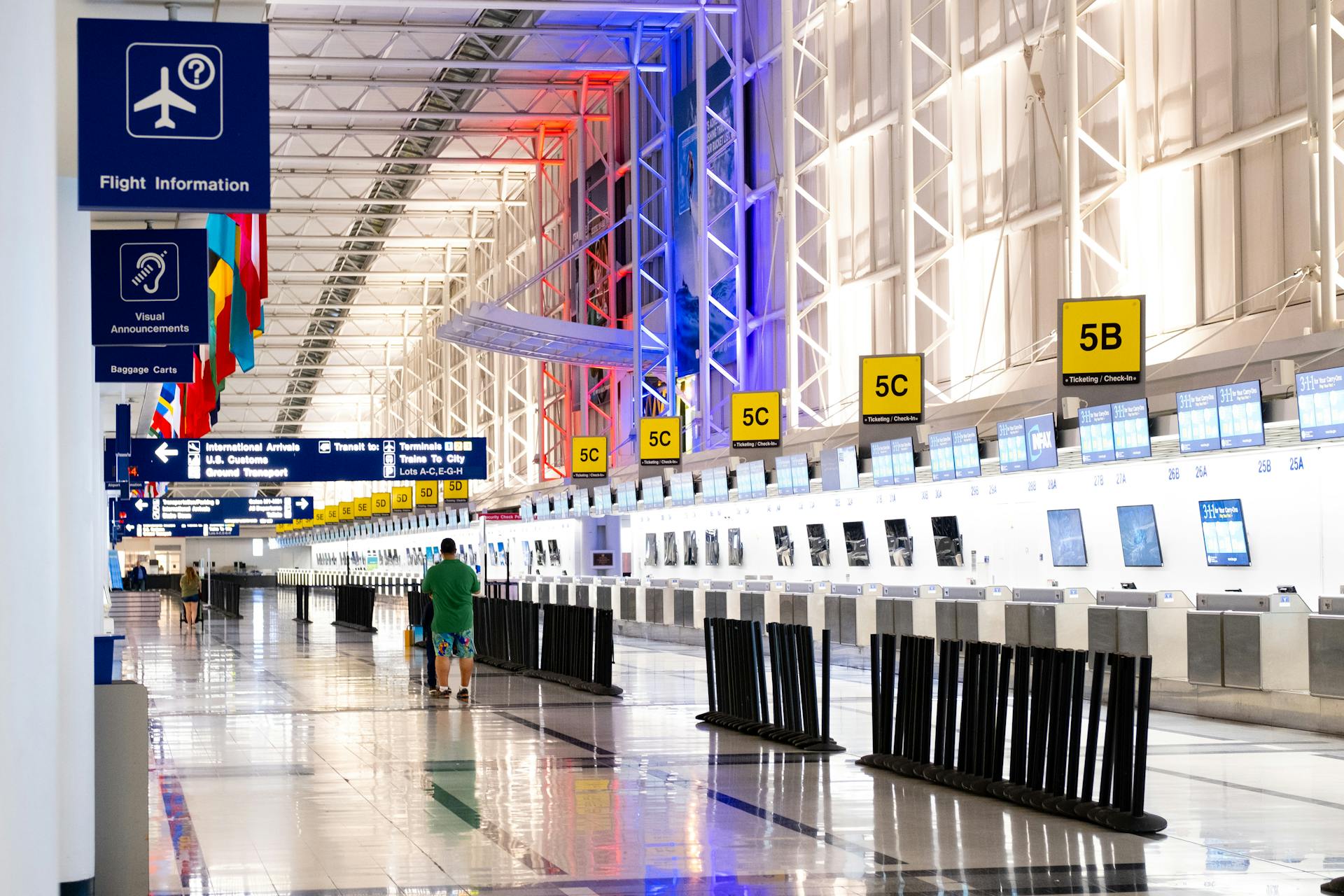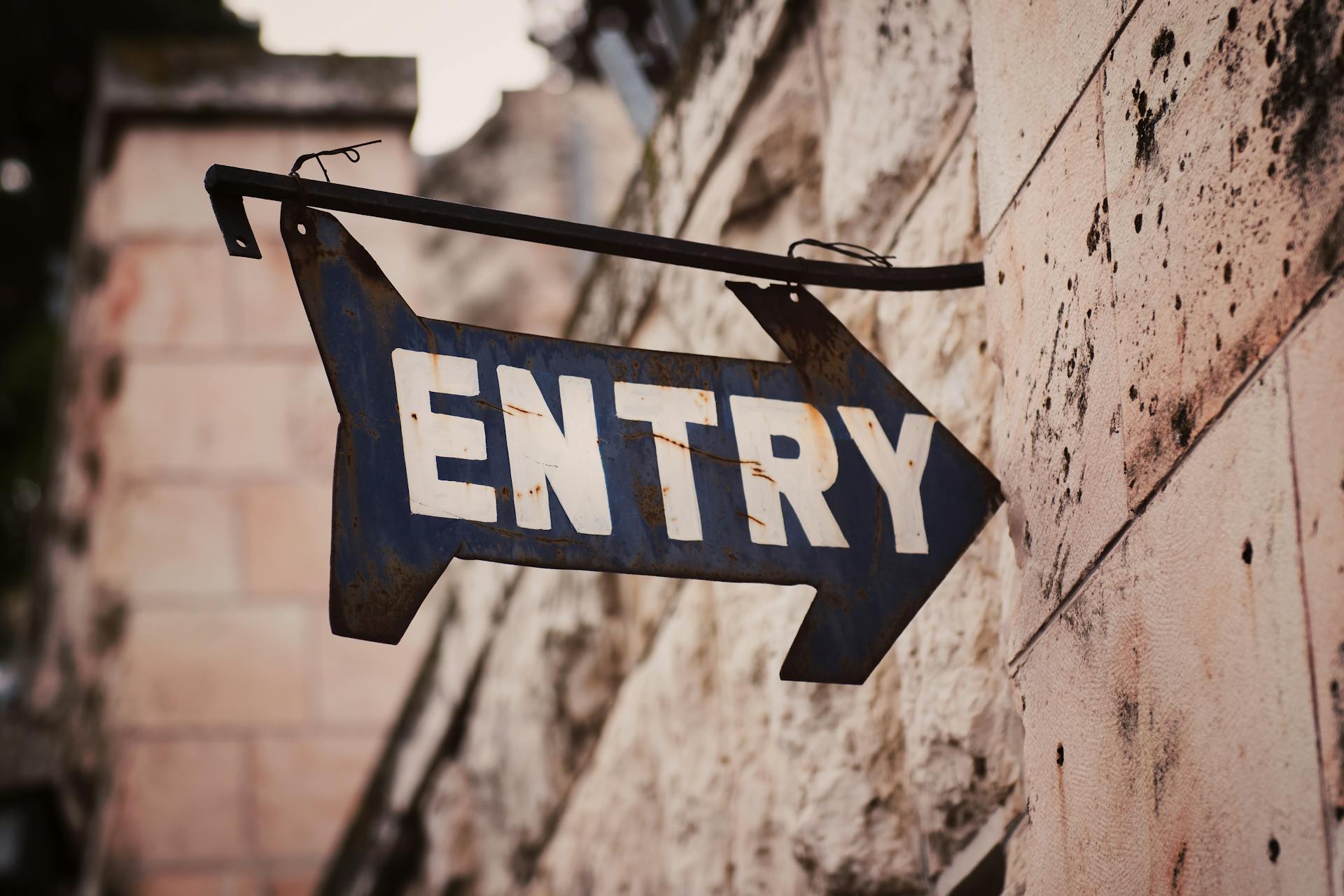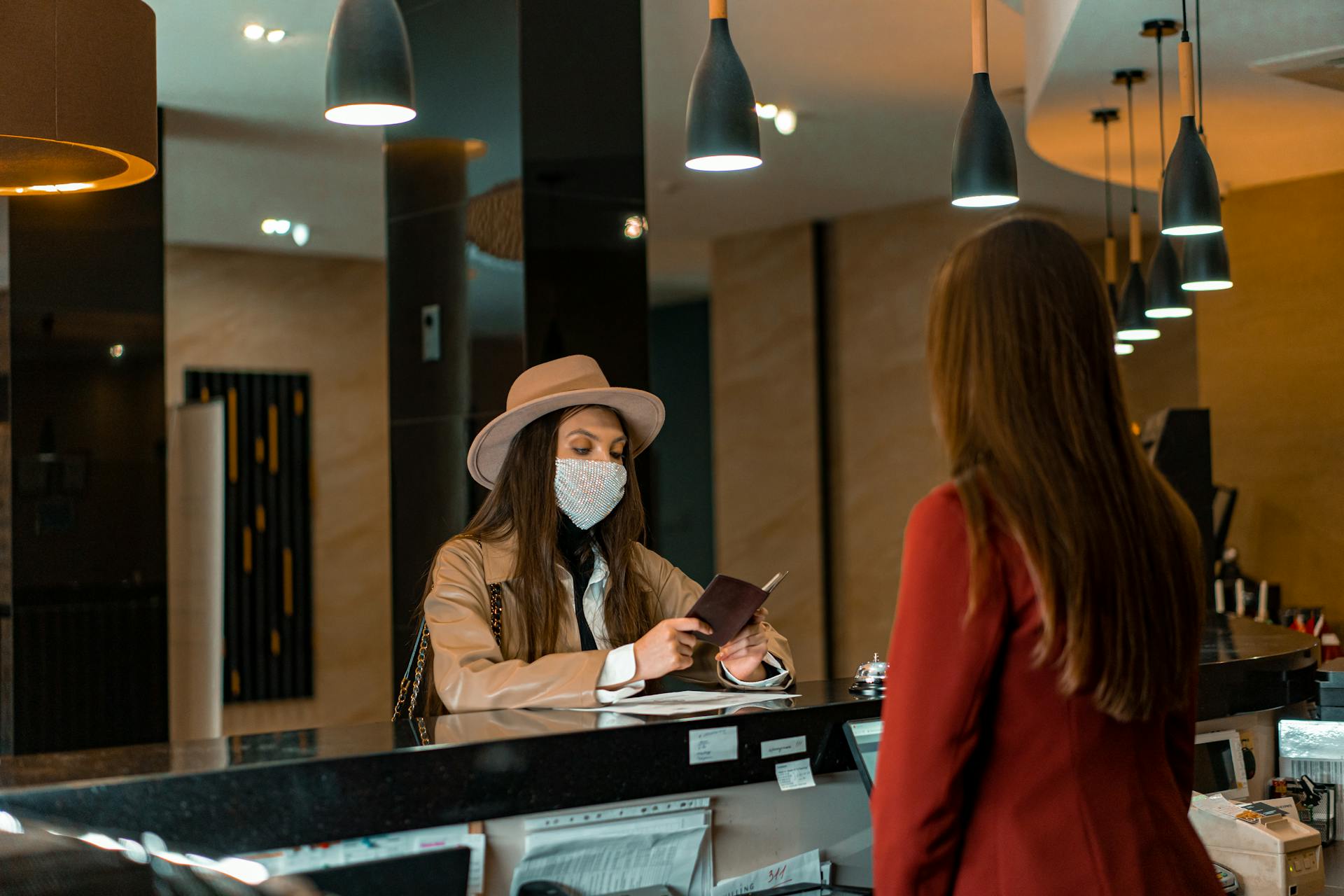
If you're an international traveler arriving at Lisbon Airport, you'll need to navigate the customs process. The airport is a major hub for European travel, with millions of passengers passing through each year.
Lisbon Airport is a relatively straightforward airport to navigate, but it's still a good idea to familiarize yourself with the customs process before you arrive. This will help you avoid any unexpected delays or issues.
You'll need to declare any goods you're bringing into Portugal, including gifts, souvenirs, and any restricted or prohibited items. Make sure you have all necessary receipts and documentation for any items you're bringing in.
Customs officers at Lisbon Airport are generally friendly and efficient, but they may ask you questions about your goods or require additional information.
Airport Arrival
Passengers arriving from outside the Schengen zone will have to go through immigration and passport control.
If you're a Schengen-zone citizen, you can use electronic barriers and national identity cards in place of passports.
Non-Schengen citizens will have to queue up to speak with an immigration officer, which can be a lengthy process for some.
A long queue often forms when flights from South America and Africa land, and citizens of all non-Schengen countries use the same queue.
After clearing immigration, you'll head through the customs area, where you'll use the green channel/passage if you have nothing to declare.
If you have items subject to import duty, you'll use the red channel.
Passengers arriving from European Union countries within the Schengen zone face no entry formalities, which is a big plus for those traveling from within the EU.
EU non-Schengen arrivals are subject to immigration, but not customs, so be prepared for that extra step.
Schengen non-EU arrivals are subject to customs, but not immigration, which can be a bit of a surprise for some.
Recommended read: Customs Inspection - Import
Security and Customs
To ensure a smooth journey through Lisbon Airport, it's essential to understand the security screening process. This involves presenting your boarding pass and ID, and being prepared to have your personal items and electronics screened.
Personal items, including jackets, belts, and shoes, may need to be placed in a tray for X-ray screening. Laptops and other large electronic devices must be removed from your carry-on baggage and screened separately.
Liquids, aerosols, and gels (LAGs) are subject to restrictions, with containers of no more than 100ml required in a single, transparent, resealable plastic bag of no more than 1 liter in capacity. Medications, baby food, and special dietary requirements are exceptions, but should be presented separately at the checkpoint.
Some items are prohibited in carry-on or checked baggage, including sharp objects, flammable materials, and certain batteries. Check the Lisbon Airport website for a detailed list of prohibited items to avoid delays or confiscations.
Upon arrival, you'll encounter two channels: green (nothing to declare) and red (goods to declare). If you're carrying goods that exceed the allowances, or if you're unsure about your items, you should go through the red channel to declare them.
Some restricted or dutiable items include wine, tobacco, new items still in packaging, and powdered milk for babies, among others. Be sure to check the allowed quantities and any special requirements for these items.
Intriguing read: Ncl Cruise Check in
Navigating Through
Navigating through customs can be a daunting task, especially if you're not familiar with the procedures. Understanding what items need to be declared and what's allowed duty-free can significantly ease your passage.
For passengers arriving in Portugal, there are two channels: green (nothing to declare) and red (goods to declare). If you're carrying goods that exceed the allowances or are unsure about your items, you should go through the red channel to declare them.
The duty-free allowances are quite generous, but it's essential to know what's restricted or prohibited. Some items, like wine, tobacco, and new items still in packaging, require special attention.
If you're carrying fish, make sure it's not disemboweled and doesn't exceed 20 kg. And, if you're traveling with medicines or foodstuffs, ensure they won't harm national health.
Here's a quick rundown of restricted or dutiable items to keep in mind:
- Wine
- Tobacco
- New items still in packaging
- Essences for regional wine counterfeit
- Systems for copying mail stamping systems
- Fish if it is disemboweled (cannot exceed 20 kg)
- Medicines and foodstuffs harmful to national health and drugs
- Powdered milk for babies, food for children and special medical food (including pet food) may be allowed if not requiring refrigeration and with original, unbroken seal
- Coats, fur and leather shoes made of protected animals (special authorization required)
- Hunting and civilian guns only (guns needs a property title and also need to be mentioned on the Consulate certificate)
- Firearms, cut and thrust weapons, and any instrument without specific application
Remember to always check the weight and quantity limits for certain items, especially when it comes to powdered milk and food for children.
Security Screening Process
To avoid any delays or complications, it's essential to understand the security screening process at Lisbon Airport. You'll need to present your boarding pass and possibly your identification when approaching the security checkpoint.
Personal items, including your jacket, belt, and shoes, may need to be placed in a tray for X-ray screening. This includes laptops, tablets, and other large electronic devices, which must be removed from your carry-on baggage and screened separately.
There are restrictions on carrying Liquids, Aerosols, and Gels (LAGs) in your hand luggage. All liquids must be in containers of no more than 100ml and placed together in a single, transparent, resealable plastic bag of no more than 1 liter in capacity.
Some items are not allowed in your carry-on or checked baggage, including sharp objects, flammable materials, and some batteries. You can find a detailed list of prohibited items on the Lisbon Airport website.
You may be required to pass through a metal detector or a full-body scanner. If a pat-down is necessary, it will be conducted by an officer of the same gender, with respect for your privacy and dignity.
If you have any medications, baby food, or special dietary requirements, you'll need to present them separately at the checkpoint. This will help expedite the screening process and ensure that you can bring these essential items with you on your journey.
You might like: Lisbon Portugal in May
Biometric Identification

Biometric Identification is a game-changer for travelers. It uses unique physical or behavioral characteristics, such as facial features, to verify identities.
At Lisbon Airport, biometric identification technology is utilized to offer a faster and more secure way to travel. This cutting-edge technology has been implemented to enhance security and convenience.
Enrolling in the biometric system is a straightforward process. On your first visit, you'll need to capture your biometric data, such as a facial scan, which is then securely stored for future use.
The benefits of biometric identification are numerous. The primary benefits include enhanced security, as biometric data is unique to each individual, and efficiency, reducing the time spent in queues and removing the need for repeated document checks.
Here's a quick rundown of the biometric identification process at Lisbon Airport:
- Enrollment: Capture biometric data, such as a facial scan, on your first visit.
- Usage: Use biometric lanes at check-in, security checkpoints, and boarding gates.
- Benefits: Enhanced security and efficiency.
Travel and Shopping
Lisbon Airport has a dedicated shopping area, including a duty-free shop for passengers departing from the airport.
You can find a variety of shops selling everything from perfumes to electronics, all with tax-free shopping options for international travelers.

The airport has a range of restaurants and cafes, from traditional Portuguese cuisine to international fast food chains.
You can also grab some last-minute souvenirs or gifts at one of the many shops selling local products, such as traditional crafts and ceramics.
If you're looking for a more unique shopping experience, consider visiting the airport's shopping mall, which offers a range of high-end brands and designer stores.
Make sure to check the opening hours of your chosen shops and restaurants to ensure you have enough time to explore before your flight.
Airport Procedures
Arrival procedures at Lisbon Airport can be a bit confusing, but don't worry, I've got the lowdown.
Passengers arriving from outside the Schengen zone will have to go through immigration and passport control, which can be a lengthy process for non-Western citizens.
Schengen-zone citizens can use electronic barriers and national identity cards in place of passports, making the process much quicker.
A long queue often forms when flights from South America and Africa land, and citizens of all non-Schengen countries use the same queue.
After baggage claim, you'll head through the customs area, where you'll use the green channel/passage if you have nothing to declare or the red channel if you have items subject to import duty.
Passengers arriving from European Union countries within the Schengen zone face no entry formalities.
EU non-Schengen arrivals are subject to immigration, but not customs, while Schengen non-EU arrivals are subject to customs, but not immigration.
If you're flying outside the Schengen zone from Terminal 1, you'll use gates 41–47 and have to go through passport exit controls, which can be quite speedy and efficient at other times, but expect delays during peak periods.
It's essential to give yourself plenty of time to navigate the security checkpoint, which is notorious for long delays.
You can skip the queue with Fast Track (€9), which is worth considering if you're short on time.
Here's an interesting read: Time Lisbon Portugal
Frequently Asked Questions
How long does customs clearance take in Portugal?
Customs clearance in Portugal now takes an average of 4 weeks, significantly faster than the previous 8 weeks. For smooth processes, it can be completed in just 2 business days
How long does it take to get through arrivals at Lisbon Airport?
Arrivals at Lisbon Airport take about 1 hour to clear. Plan ahead to make the most of your time
Sources
- https://www.aeroporto-lisboa.com/en/things_to_know_and_visa_portugal.php
- https://www.worldbaggagenetwork.com/kb/portugal/2-customs-regulations-for-your-trip-to-portugal/
- https://community.ricksteves.com/travel-forum/portugal/estimated-time-to-clear-customs-after-arrival-in-lisbon
- https://en.wikivoyage.org/wiki/Lisbon_Airport
- https://www.lisbon-airport.com/passenger-guide.html
Featured Images: pexels.com


